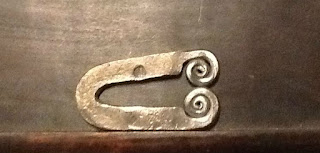Like so much involving Mexican military items from the 1820's-1840's, quality reproductions are few and far between. That's why it was exciting when Corps Sutler, based out of New Zealand who previously produced Napoleonic & other era items stepped in to fill a void amongst Mexican Soldado living historians. The idea of readily available Mexican reproductions such as buckles and shako plates proved tempting as multiple Tex. Rev reenactors began purchasing shako plates, as well as Cross belt buckles.
The Cross belt buckle is the first item I will be reviewing in a series of product reviews for individuals interested in making purchases.
To start let's look at the original piece, currently housed at the Bob Bullock Museum in Austin.
Listed as a "Mexican Staff Officer's Belt Buckle" This piece is on loan from the Texas Museum of Military History. Some specifics, this buckle is solid cast, appears to be brass, possibly silver. This is not a "stamped" piece, it is cast.
I recently purchased the Corps Sutler version, this is the picture from their website.
Although it's difficult to see, the piece is stamped, with the hook and studs attached via sodering. The hook is pretty bendable, and I actually wonder how breakable it is. The thickness is substantially different, the repro is stamped of a thin brass, I assume. It's actually difficult to tell because the entire piece is covered in this really bright goldish finish. The Eagle itself is pretty true to the original, it's a unique piece and the likeness and size matches, but the weight of the original seems so much more solid it's striking. I've seen one more repro of this plate, a solid brass casting from the 2004 Alamo movie, again, being solid brass makes it much truer to the original.
Accuracy: 6/10 (Likeness is good, but the weight, color, metal are totally different.
Use: 7/10 (Great if you're an officer using an over the shoulder belt, but this is not for line troops, it's too fanciful and is very different from dug original Crossbelt plates.
Purchase: If you're portraying an officer and using a British 1796, this buckle is passable, however I would love to see one of the more established Brass casters take a swing at this piece and make something a little more solid. I bought mine for $30 and it was a sale. For that price this buckle is ok, but again, the impression determines it use, I would not want to see this worn by line troops, but line officers and staff might find it useful.






